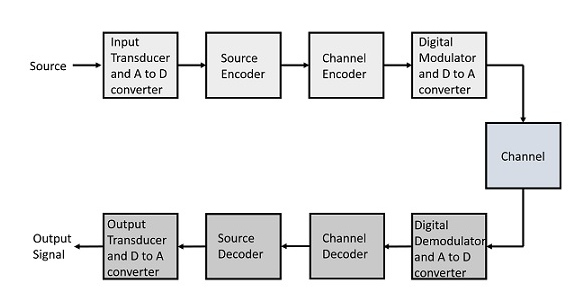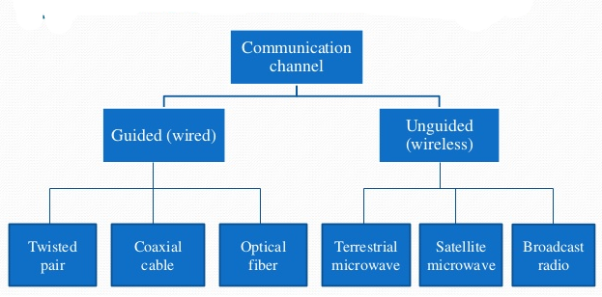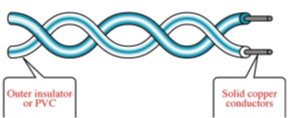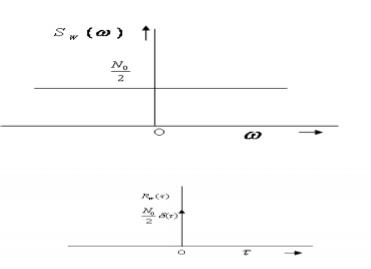Unit - 1
Introduction
The elements which form a digital communication system is represented by the following block diagram for the ease of understanding.

Fig 1 Elements of Digital Communication System
Following are the sections of the digital communication system.
Source
The source can be an analog signal.
Example: A Sound signal
Input Transducer
This is a transducer which takes a physical input and converts it to an electrical signal. This block also consists of an analog to digital converter where a digital signal is needed for further processes.
A digital signal is generally represented by a binary sequence.
Source Encoder
The source encoder compresses the data into minimum number of bits. This process helps in effective utilization of the bandwidth. It removes the redundant bits unnecessary excess bits, i.e., zeroes.
Channel Encoder
The channel encoder, does the coding for error correction. During the transmission of the signal, due to the noise in the channel, the signal may get altered and hence to avoid this, the channel encoder adds some redundant bits to the transmitted data. These are the error correcting bits.
Digital Modulator
The signal to be transmitted is modulated here by a carrier. The signal is also converted to analog from the digital sequence, in order to make it travel through the channel or medium.
Channel
The channel or a medium, allows the analog signal to transmit from the transmitter end to the receiver end.
Digital Demodulator
This is the first step at the receiver end. The received signal is demodulated as well as converted again from analog to digital. The signal gets reconstructed here.
Channel Decoder
The channel decoder, after detecting the sequence, does some error corrections. The distortions which might occur during the transmission, are corrected by adding some redundant bits. This addition of bits helps in the complete recovery of the original signal.
Source Decoder
The resultant signal is once again digitized by sampling and quantizing so that the pure digital output is obtained without the loss of information. The source decoder recreates the source output.
Output Transducer
This is the last block which converts the signal into the original physical form, which was at the input of the transmitter. It converts the electrical signal into physical output.
Output Signal
This is the output which is produced after the whole process.
Key takeaway
The channel decoder, after detecting the sequence, does some error corrections. The distortions which might occur during the transmission, are corrected by adding some redundant bits.
Communication channel is a connection between transmitter and receiver through which data can be transmitted. They are also called as communication media or transmission media.
The basic types of communication channel can be categorised as

Fig 2 Communication Channel
Twisted Pair Cable
One of the wires carries signal, the other is used only as a ground reference. Number of twists per unit length determines the quality of the cable.

Fig 3 Twisted pair cable
Types of Twisted pair cable
- Shielded twisted pair cable
- Unshielded twisted pair cable
- Categories off Twisted pair cables
- Category 1- 0.1Mbps
- Category 2- 2Mbps
- Category 3 – 10Mbps
- Category 4 -20Mbps
- Category 5 – 100Mbps
- Category 6- 200Mbps
- Category 7- 600Mbps

Fig 4 Interior of cables
Coaxial cable
It us used for both analog and digital signals. They effectively used at higher data rate and higher bandwidth. For analog signals need amplifiers every few km. For digital signals require every 1km.

Fig 5 Coaxial cable
Optical fibre cable
A fibre -optic cable is composed of very thin strands of glass or plastic known as optical fibres one cable can have as few as two strands or as many as several hundreds of them. These optical fibre cables carry information in the form of data between two places using optical or light-based technology. Once the light beams travel down the optical fibre cable (OFC), they would emerge at the other end.

Fig 6 Optical Fiber Cable
The basis on refractive index OFC is of two types:
Step Index Fibbers: It comprises a core enclosed by the cladding, which has a single uniform index of refraction.
Graded Index Fibbers: The refractive index of the optical fibre decreases as the radial distance from the fibre axis increases.
Based on materials, OFC is of 2 types:
Plastic Optical Fibbers: The poly (methyl methacrylate) is used as a core material for the transmission of light.
Glass fibres: It consists of extremely fine glass fibres.
Based on the mode of propagation of light, OFC is divided into:
Single-Mode fibres: Used for long-distance transmission of signals.
Multimode fibres: Used for short-distance transmission of signals.
Terrestrial microwave
They require very few repeaters. The use parabolic dish to focus a narrow beam. They work on frequencies between 1-40GHz.
Satellite Communication
It receives only one frequency and transmits on another frequency. This means that the uplink frequency ranges from 5.925-6.425GHz and downlink frequency of 3.7-4.2 GHz. They work over a height of 35,784km. The speed of transmission is at least 3-40 apart.
Broadcast Radio
The radio frequency ranges from 3kHz-300GHz. They use broadcast radio of 30MHz-1GHz, for FM radio and UHF and VHF television. The transmission is unidirectional. It suffers from multipath interference due to reflections from land, water and other objects. They are used for multicast communications such as radio and television and also for paging systems.
Key takeaway
- Communication channels are essential for communication systems. The transmission characteristics are important in selecting channel because they directly affect the communication quality.
- Different types of communication channels have different transmission characteristics and costs, they are used in different applications.
The mathematical model reflects the most important characteristics of the system. Channel mathematical model helps to design channel encoder and modulator at receiver and channel decoder and demodulator at receiver side.
Additive noise channel
It is simplest mathematical model. The transmitted signal S(t) corrupted by an additive random noise process n(t). This n(t) arises from electrical components. If noise is introduced primarily at receiver side by components it may be characterized as thermal noise. This type of noise is characterised as Gaussian noise process. The model mathematical model for this channel is called additive Gaussian noise channel.
A signal may be contaminated along the path by noise. Noise may be defined as any unwanted introduction of energy into the desired signal.
In radio receivers’ noise may produce hiss in the loud speaker output. Hence noise is random and unpredictable.
Noise is produced in both external and internal to the system.
External noise includes
- Atmospheric noise (lightening)
- Galactic noise (thermal radiation)
- Industrial noise (from motors, ignition)
We can minimize or eliminate external noise by proper system design.
Internal noise is generated inside the system. It is resulted due to random motion of charged particles in resistors, conductors and electronic devices.
With proper design it can be minimized but never can be eliminated.
Types of Noise
- White Noise
- Thermal noise
- Shot noise
- Partition noise
- Low frequency or flicker noise
- Burst noise
- Avalanche noise
- White Noise
One of the important random processes is the white noise process. Noises in many practical situations are approximated by the white noise process.
White noise plays an important role in modelling of WSS signals. A white noise process W(t) is a random process that has constant power spectral density at all frequencies.
Thus
S w(w) = N0/2 ----------------(1) - ∞<w<∞
Where No is real constant and called the intensity of the white noise. The corresponding autocorrelation is given by
Rw ( = N/2
= N/2  (
( where
where  (
( is the Dirac delta.
is the Dirac delta.
The average power of white noise
P wg = E W 2 = 1/2π dw -> ∞
dw -> ∞
The autocorrelation function and the PSD of white noise process is shown in Figure.

Fig.7 Autocorrelation function
- Thermal Noise
- Thermal noise is the electronic noise generated by thermal agitation of charge carriers inside an electrical conductor in equilibrium, which happens regardless of any applied voltage.
- Movement of electrons will form kinetic energy in the conductor related to temperature in the conductor.
- When the temperature increases the movement of electrons increases and current flows through the conductor.
- Current flows due to free electrons which create noise voltage n(t).
- Noise voltage is influenced by temperature hence it is called thermal noise.
Q. Calculate the thermal noise power available from any resistor at room temperature (290K) for a bandwidth of 1Mhz. Calculate also the corresponding noise voltage given that R = 50 Ω.
Pn = 1.38 x 10 -23 x 290 x 10 6
= 4 x 10 -15.
En2 = 4 x 50 x 1.38 x 10 -23 x 290
= 0.895 µ V
- Shot Noise
- Shot noise arises because the current consists of a vast number of discrete charges.
- The continuous flow of these discrete pulses gives rise to almost white noise. There is a cut-off frequency by the time it takes for the electron or other charge carrier to travel through the conductor.
- Unlike thermal noise, this noise is dependent upon the current flowing and has no relationship to the temperature at which the system is operating.
- Shot noise is more apparent in devices such as PN junctions. The electrons are transmitted randomly and independently of each other.
- Partition Noise
When the circuit is to divide in between two or more paths then the noise generated is known as Partition noise. The reason for this generation is random fluctuation in the division.
- Flicker Noise
Flicker noise or modulation noise is the one appearing in transistors operating at low audio frequencies. Flicker noise is proportional to the emitter current and junction temperature. However, this noise is inversely proportional to the frequency.
- Burst Noise
Burst noise consists of step-like transitions suddenly between two or more discrete voltages or current levels.
Each shift in offset voltage or current lasts for millisecond to seconds. It is also known as popcorn noise because of the popping or crackling sound it produces in audio circuits.
- Avalanche Noise
Avalanche noise is the noise produced when a junction diode is operated at the onset of avalanche break down, a semiconductor junction phenomenon in which the carriers having high voltage gradient develop sufficient energy to dislodge additional carriers through physical impact creating ragged current flow.
Key Takeaways:
- The average power of white noise
P wg = E W 2 = 1/2π dw -> ∞
dw -> ∞
2. Noise may be defined as any unwanted introduction of energy into the desired signal.
References:
[1] John G.Proakis, M. Salehi, Communication Systems Engineering, 2nd ed. New
Delhi, India. PHI Learning Private Limited, 2009.
[2] R.P Singh and S.D Sapre, Communication Systems Analog & Digital, 2nd ed. New Delhi, India. Tata McGraw Hill Education Private Limited, 2009.